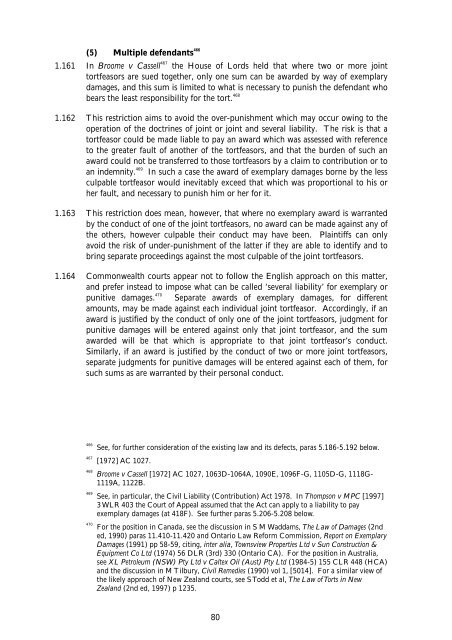Aggravated, Exemplary and Restitutionary ... - Law Commission
Aggravated, Exemplary and Restitutionary ... - Law Commission
Aggravated, Exemplary and Restitutionary ... - Law Commission
Create successful ePaper yourself
Turn your PDF publications into a flip-book with our unique Google optimized e-Paper software.
(5) Multiple defendants 466<br />
1.161 In Broome v Cassell 467<br />
the House of Lords held that where two or more joint<br />
tortfeasors are sued together, only one sum can be awarded by way of exemplary<br />
damages, <strong>and</strong> this sum is limited to what is necessary to punish the defendant who<br />
bears the least responsibility for the tort. 468<br />
1.162 This restriction aims to avoid the over-punishment which may occur owing to the<br />
operation of the doctrines of joint or joint <strong>and</strong> several liability. The risk is that a<br />
tortfeasor could be made liable to pay an award which was assessed with reference<br />
to the greater fault of another of the tortfeasors, <strong>and</strong> that the burden of such an<br />
award could not be transferred to those tortfeasors by a claim to contribution or to<br />
an indemnity. 469<br />
In such a case the award of exemplary damages borne by the less<br />
culpable tortfeasor would inevitably exceed that which was proportional to his or<br />
her fault, <strong>and</strong> necessary to punish him or her for it.<br />
1.163 This restriction does mean, however, that where no exemplary award is warranted<br />
by the conduct of one of the joint tortfeasors, no award can be made against any of<br />
the others, however culpable their conduct may have been. Plaintiffs can only<br />
avoid the risk of under-punishment of the latter if they are able to identify <strong>and</strong> to<br />
bring separate proceedings against the most culpable of the joint tortfeasors.<br />
1.164 Commonwealth courts appear not to follow the English approach on this matter,<br />
<strong>and</strong> prefer instead to impose what can be called ‘several liability’ for exemplary or<br />
punitive damages. 470<br />
Separate awards of exemplary damages, for different<br />
amounts, may be made against each individual joint tortfeasor. Accordingly, if an<br />
award is justified by the conduct of only one of the joint tortfeasors, judgment for<br />
punitive damages will be entered against only that joint tortfeasor, <strong>and</strong> the sum<br />
awarded will be that which is appropriate to that joint tortfeasor’s conduct.<br />
Similarly, if an award is justified by the conduct of two or more joint tortfeasors,<br />
separate judgments for punitive damages will be entered against each of them, for<br />
such sums as are warranted by their personal conduct.<br />
466 See, for further consideration of the existing law <strong>and</strong> its defects, paras 5.186-5.192 below.<br />
467 [1972] AC 1027.<br />
468 Broome v Cassell [1972] AC 1027, 1063D-1064A, 1090E, 1096F-G, 1105D-G, 1118G-<br />
1119A, 1122B.<br />
469 See, in particular, the Civil Liability (Contribution) Act 1978. In Thompson v MPC [1997]<br />
3 WLR 403 the Court of Appeal assumed that the Act can apply to a liability to pay<br />
exemplary damages (at 418F). See further paras 5.206-5.208 below.<br />
470 For the position in Canada, see the discussion in S M Waddams, The <strong>Law</strong> of Damages (2nd<br />
ed, 1990) paras 11.410-11.420 <strong>and</strong> Ontario <strong>Law</strong> Reform <strong>Commission</strong>, Report on <strong>Exemplary</strong><br />
Damages (1991) pp 58-59, citing, inter alia, Townsview Properties Ltd v Sun Construction &<br />
Equipment Co Ltd (1974) 56 DLR (3rd) 330 (Ontario CA). For the position in Australia,<br />
see XL Petroleum (NSW) Pty Ltd v Caltex Oil (Aust) Pty Ltd (1984-5) 155 CLR 448 (HCA)<br />
<strong>and</strong> the discussion in M Tilbury, Civil Remedies (1990) vol 1, [5014]. For a similar view of<br />
the likely approach of New Zeal<strong>and</strong> courts, see S Todd et al, The <strong>Law</strong> of Torts in New<br />
Zeal<strong>and</strong> (2nd ed, 1997) p 1235.<br />
80
















